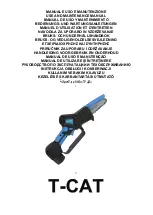
24 • ENGLISH
Important! Blade rotation is clockwise when observing
from the right side of the saw. Make sure the rotation
direction mark on blade matches with that.
BASIC TABLE SAW OPERATIONS
a. When crosscutting, miter cutting, bevel cutting,
compound miter cutting or rabbeting across the end of
a narrow work-piece, use the miter gauge.
b. Never make these cuts freehand (not using the miter
gauge or other devices) because the blade could bind,
causing a kickback or causing your hand or fingers to
contact the blade.
c. Always lock the angle of the miter gauge when in use.
d. Except for when making rip cuts, remove the rip fence
from the table (5).
e. Make sure the blade guard is mounted for all through
sawing operations (the blade cuts through the entire
thickness of the wood). Re-attach the guard
immediately after finishing dado, molding or rabbeting
cuts.
f. The blade should extend approximately 1⁄8” (3 mm)
above the top of the work-piece.
g. Use the push stick whenever you make a narrow cut.
Crosscutting (see Fig. R)
Crosscutting is cutting wood across the grain at 90° or
square with both the edge and the flat side of the wood.
This is done with the miter gauge set at “0”. Before using
the miter gauge, make sure it is locked. The miter gauge
can be used in either of the grooves in the table.
Miter crosscutting (See Fig. S)
Miter crosscutting is cutting the wood at an angle other
than 90°. Follow the same procedures as you would for
crosscutting. Adjust the miter gauge to the desired angle.
Bevel crosscutting (See Fig. W)
Bevel crosscutting is the same as crosscutting except that
the blade is also set at an angle other than 90º. Adjust the
blade to the desired angle using the blade tilting wheel.
Compound miter cutting (See Fig. X)
Compound miter cutting is a combination of miter cutting
and bevel crosscutting. The cut is made at an angle other
than 90° to both the edge and the flat side of the wood.
Adjust the miter gauge and the blade bevel to the desired
angle and be sure that the miter gauge and blade bevel
stop collar are locked.
Ripping (See Fig. Q)
Ripping is cutting a piece of wood with the grain. This
is done using the Rip Fence. Position the fence to the
desired width of the rip cut and lock it in place. Before
starting to rip, make sure:
a. The rip fence is parallel to the saw blade.
b. The splitter is properly aligned with the saw blade.
When ripping long boards or large panels, always
use a work-piece support. Hold the material to be
cut against the rip fence and feed it through the blade
with smooth, steady pressure.
Only apply feed pressure to the work-piece between the
blade and the rip fence in order to prevent the work-piece
from binding against the blade and causing kickback.
When ripping boards narrower than 6” (150 mm), use a
push stick to feed the work-piece until it is clear of the
table.
Bevel ripping (See Fig. T)
When bevel ripping material 6” (150 mm) or narrower, use
the rip fence on the right side of the blade only.
U
Blade throat
plate
V
W
X
Содержание STST1825-AR
Страница 2: ...FIG A 11 12 6 8 9 1 2 10 7 3 4 5...





































